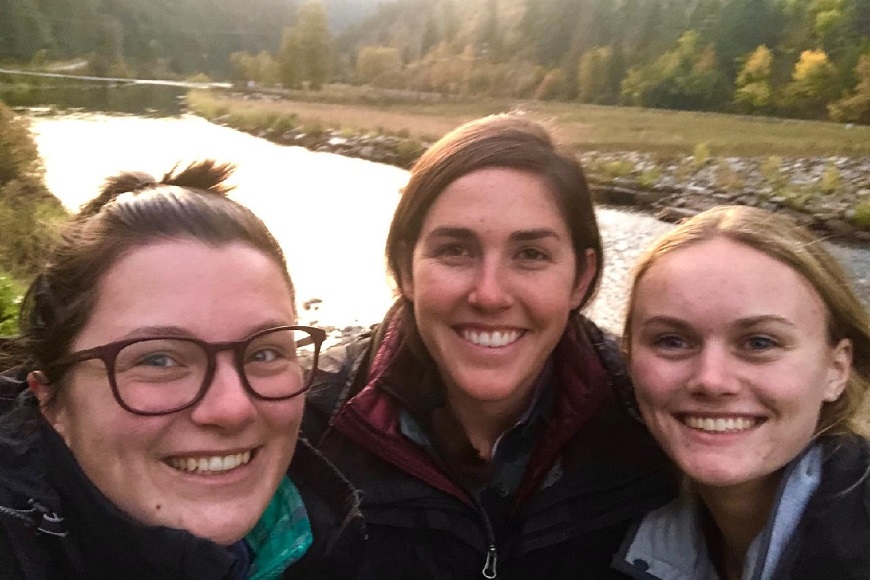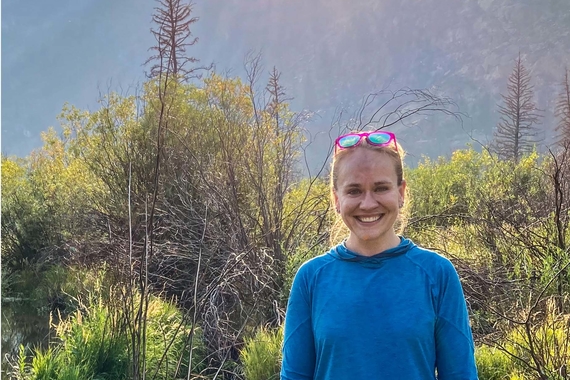Making Moves to Protect Our Forests
Like many high school graduates, Erika Eidson knew she wanted to pursue a college degree but had no idea where to start or what she wanted to do.
Although she applied to several schools, the University of Minnesota caught her eye because of its variety of degree programs. She adds, “As a Wisconsin resident, the reciprocity tuition didn’t hurt either!”
Her acceptance into UMN in 2007 would prove to be more than she ever imagined, exposing her to new and exciting academic opportunities through the Department of Geography, Environment & Society (GES) and a fulfilling, yet sometimes unpredictable, career in forestry.
The More Degrees the Merrier
“I would say [Kurt Kipfmueller’s] class [Biogeography of the Global Garden] is what made me realize I wanted to study natural resources,” Eidson explains.
She says it taught her how natural systems work together while realizing there is important work to be done in this field, like managing invasive species that harm forests, and she was hooked.
She proceeded to declare two majors—one in geography and another in environmental science, policy, and management, along with minors in Spanish and forest resources.
“All the degree declarations were a bit of a journey!” Eidson says.
She emphasizes how grateful she is that she decided to get a minor in Spanish, as it allowed her to communicate with and translate for Spanish-speaking residents while working in Aurora, Colorado. Even more importantly, her other minor in forest resources through the College of Food, Agricultural and Natural Resource Sciences (CFANS) is what has helped her land jobs, as well as helping her realize what her passion is—forestry.
During her undergraduate years, Eidson was also able to complete two research projects through the Undergraduate Research Opportunities Program (UROP). For the first project, she paired with Kipfmueller to explore differences in tree growth rings between upland and lowland black spruce trees. For the second, she paired with Scott St. George, another GES professor, to look at whether tree rings in oaks could record flood events in the Red River Valley. With St. George’s help, Eidson was able to present their findings about oak tree rings at the Association of American Geographers conference in New York in 2012, in addition to publishing them in an academic journal.
“[Being published] was a really cool achievement for an undergraduate and helped a lot when I was applying to graduate schools,” Eidson explains.
Her research with St. George also won the geography department’s Outstanding Senior Project Award in geography in 2012.
Destined for Forestry
After graduating from UMN in May 2012, Eidson moved west with her husband and settled down in Canon City, Colorado for a seasonal job doing forest inventory and analysis (FIA) for the Colorado State Forest Service.
FIA is a national program where forest plots across the country are installed and remeasured on various timelines. Eidson explains how she saw just about every corner of Colorado and was outside almost every day—which had its downsides and advantages. She says, “Sometimes the fieldwork was a little gnarly. We had to do a plot inside an electric bullpen, I sat on a cactus, a tarantula crawled up my boot, and I almost put my hand down on a rattlesnake, [all while working there].”
Regardless, Eidson says she gained a lot from the work, too, especially field data collection skills.
After about six months, her husband got a job in Denver, they moved again, and she had to work a desk job for six weeks.
“It was really hard for me to go from hiking around in boots and flannel every day to sitting all day in high heels and dress pants,” Eidson explains. Eventually, she secured a job as a forestry inspector for the city of Aurora’s forestry division, responding to tree-related questions from city residents.
“I really learned a lot about urban forestry, hazard trees, and forest insects and disease, as well as customer service,” Eidson says.
Two years later she made the decision to attend graduate school at Utah State University, completing her master’s degree in forestry with a thesis focused on mountain pine beetles. During her last semester before graduation in 2017, she was hired by the Idaho Department of Lands (IDL) to help protect forests from losses due to insects and disease.
Her team in Idaho, along with Kipfmueller and collaborators from the University of Idaho and the US Forest Service, worked on a project to collect tree cores in an effort to monitor an invasive insect called the balsam woolly adelgid. At the same time, two current GES undergraduates, Madison Pettersen-Bradford and Cait Bell, mounted and measured the tree cores.
“They had been in the lab staring at all of these tree cores but had never seen the forests where they came from,” Eidson adds. To give the students the opportunity to see the forests, Eidson and Kipfmueller agreed to send them out to work with Eidson to install monitoring plots in a large outbreak area of a native defoliating insect called the western hemlock looper. This project was important in understanding what was happening with the outbreak and how to advise foresters whose land had been impacted.
“It was really cool to be able to teach them, and they were so interested in learning,” Eidson says. She also recently hired Pettersen-Bradford, who returned to Idaho in April 2020 to work for Eidson during the summer.
A Grateful Graduate
“[My CLA education] helped me have a more well-rounded education, understand different perspectives, and meet a greater variety of people,” Eidson explains.
She says that CLA gave her the ability to explore fields of study from Spanish to forestry, and she’s grateful for the exposure to new concepts and ideas she wouldn’t have encountered outside the college. “My GES classes helped provide me with a high-level view of how different environmental systems interact, which is important for considering all factors that can influence insect populations and forest health,” Eidson adds.
While the GES department in CLA and the forest resources department in CFANS both provided her with the skills and knowledge needed to be successful in her career, Eidson emphasizes that it was the people, not just the departments, that really made a difference.
“Kurt [Kipfmueller] hired me in the tree-ring lab as a totally clueless 19-year-old my freshman year and has been a supportive mentor to me ever since,” Eidson says. She says that Scott St. George helped advance her professional career, focusing on refining her resume and professional skills, like job interviews and presentations. Instructor and advisor of the forest resources department Paul Bolstad also taught her skills in geographic information sciences courses that proved to be important in her current job.
“I am grateful to the department and the many faculty who patiently allowed me to pester them during office hours,” Eidson says.
This story was written by an undergraduate student.



